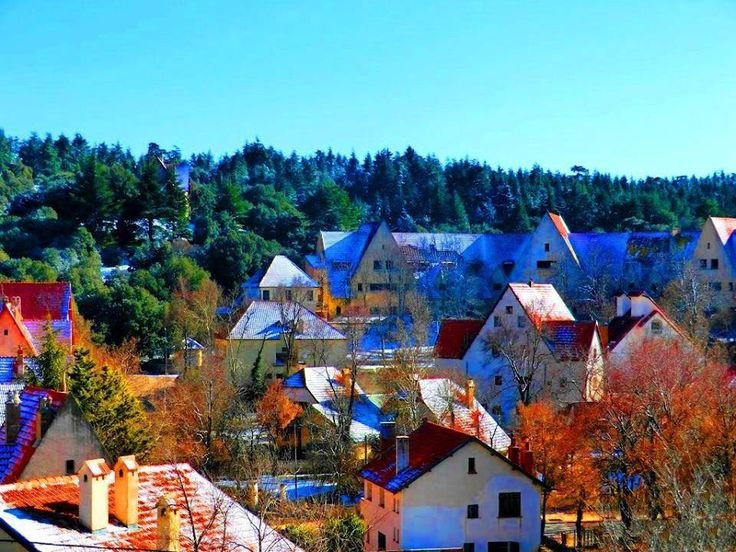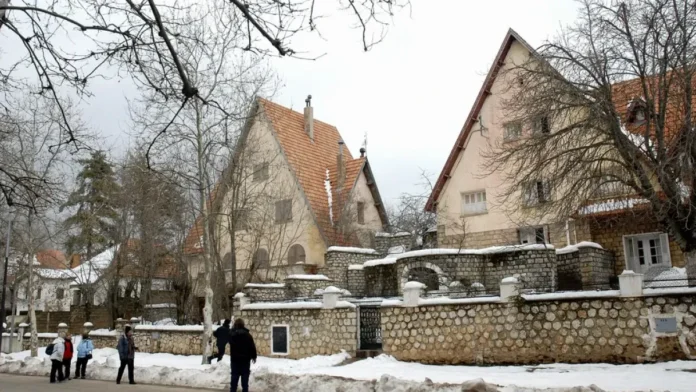Introduction
Nestled high in the snow-capped Atlas Mountains of northern Morocco lies a quaint village that feels worlds away from the rest of the country. With its chalet-style homes, picturesque meadows, wooden bridges, and ubiquitous pines, Ifrane looks and feels remarkably like villages in Switzerland. Nicknamed “Little Switzerland” or “Moroccan Switzerland,” Ifrane has captured the imagination of travelers for decades with its stunning natural beauty and distinctly European atmosphere.
While Morocco dazzles visitors with its vibrant medinas, mosques, and souks, Ifrane offers a tranquil escape into alpine scenery. Its weather is significantly cooler than along Morocco’s Mediterranean coast, with winter temperatures frequently dropping below freezing. Whether you seek crisp mountain air, breathtaking forest hikes, or a cultural experience off the typical tourist trail, a visit to Ifrane will not disappoint. Read on to discover what makes this village so enchantingly unique and why “Little Switzerland” has captured travelers’ hearts for over a century.
Early History and Development
Ifrane has only been permanently inhabited since the 1930s, though its beginnings trace back to the late 19th century. In 1889, the government of the French protectorate of Morocco began scouting locations for a royal hunting reserve high in the Atlas Mountains. They chose a site southwest of Meknes at an elevation of around 1,600 meters, where abundant forests, grasslands, and streams flourished. Over the next few decades, French agronomists developed the area by building infrastructure, establishing orchards and plantations of pine and cedar, and constructing chalets and barns in the signature Swiss style.
Interestingly, the planners of this development were likely influenced by their experiences in Switzerland. Many Frenchmen spent time working, studying, or vacationing there in the late 1800s and early 1900s, drawn by Switzerland’s natural beauty, orderly communities, and association with health, sustainability, and adventure activities like hiking. When constructing the royal reserve in the Moroccan mountains, they purposefully modeled structures and layouts after picturesque Swiss villages. This early Swiss influence is a significant reason Ifrane came to be seen as a piece of the Swiss Alps transplanted to North Africa.
The reserve proved successful, though its remoteness presented challenges. It wasn’t until the 1920s-30s that the area began attracting permanent settlers. These pioneers were mainly French colonists, civil servants, and a minority of Moroccans. Over subsequent decades, new roads, schools, a hospital, and other infrastructure were built to support a growing community centered around agriculture, forestry, and tourism.
Many French settlers departed after Moroccan independence in 1956 but continued investment fostered steady growth. Today, Ifrane boasts a population of around 30,000 and a flourishing university. Its unique amalgam of European and Moroccan cultures persists, mystifying and delighting all who pass through its storybook setting.
Natural Splendor of Ifrane’s Mountains
Situated at the junction of the Middle and High Atlas mountain systems, Ifrane is surrounded by volcanic peaks and dense cedar forests that reach elevations over 3,000 meters. Cool temperatures year-round and regular winter snow lend the area an alpine ambiance missing from sunbaked coastal Morocco.
Ascending through the lush valley leading into town, one’s first sight of snowcapped pines is arresting. Varied hiking trails crisscross surrounding hillsides, immersing visitors in the pristine mountain scenery. Day hikes to Jbel Hebri or Jbel Bouiblane reward with panoramic views over Ifrane and surrounding mountain plains. More experienced trekkers can tackle multiday circuits like the Mischliffen or Tazaghart routes deep into remote corners of the Middle Atlas range.
Wildlife is also present, from Barbary red deer to foxes, wolves, and hawks. Rare mountain endemic plants like the Ifrane cedar thrive under the supervision of Talassemtane National Park. This vast protected area encompasses over 235,000 hectares of coniferous forests, grasslands, and endangered biomes centered on Ifrane. Whether for a casual stroll or a strenuous backcountry expedition, the natural bounty on tap is a significant reason outdoor enthusiasts are drawn here repeatedly. The refreshing climate, clean air, and vistas stretching to the snowy horizons also work wonders for stress relief and rejuvenation of mind, body, and soul.
Architecture and Layout Inspired by Switzerland
Stepping off the bus from Fes or Meknes, one is immediately struck by Ifrane’s neat grid layout and architectural styles straight out of central Europe. Chalets in twee pastel colors with pitched roofs, overhanging eaves, and decorative balconies dot manicured boulevards. Picket fences, flower boxes, and manicured shrubbery line sidewalks on quiet streets that seem straight out of a postcard. Even the municipal landscaping looks distinctly Swiss, with public gardens, fountains, and Swiss-style signage pointing the way.
This idyllic scene inspired the village’s nickname, “Little Switzerland.” Though some traditional Moroccan homes are scattered throughout, the overall feel is overwhelmingly alpine. One-half expects to spot yodelers or alphorns around every corner! Wandering reveals charming touches like street names in Arabic and French script. Historic photos also show how far Ifrane has come since those early French settlers transformed an empty mountain preserve into the charming Swiss village it is today. Underneath the European overlay, though, the omnipresent call to prayer rings five times daily as a reminder of Morocco beyond the village limits.
While residents primarily speak Moroccan Arabic or Berber dialects at home, French and English are commonly used in public spaces. This multilingual milieu contributes to Ifrane’s cultural diversity. From architecture to activities, European and Moroccan influences blend seamlessly together, transported to lofty elevations far removed from North Africa’s typical tourist destinations. The result is an experience as unique as it is idyllic, leaving lasting impressions on all who venture up Morocco’s “Little Switzerland.”

Cultural Hub and University City
Another essential reason Ifrane has grown so large is its role as an educational hub and administrative center. Founded in 1975, the University of Ifrane (UFI) plays a vital intellectual and economic role. With around 15,000 students enrolled across seven faculties, it has become one of Morocco’s top universities. Programs span subjects from agriculture and forestry to engineering, economics, and sciences. State-of-the-art facilities attract ambitious students from across Morocco and beyond.
Photo by Mokrane Lahsaini on Unsplash
On sunny afternoons, the campus precinct comes alive with youthful energy. Cafés and food stalls catering to students populate the surrounding streets. Sidewalks buzz with lively conversation in many languages as friends mingle between classes. It’s a multi-faceted experience enjoying burgers and mint tea in the shadow of this prestigious center of learning.
Ifrane also hosts administrative offices for the surrounding province. As such, it sees a steady flow of civil servants, entrepreneurs, and professionals moving to the area. Accompanying their families has boosted the town’s population and diversity beyond its founding agricultural community. Meanwhile, vibrant cultural institutions like a modern library and performance spaces nurture creative spirits. Holiday festivals bring traditional music, dancing, and food to town squares yearly.
In this way, Ifrane fulfills a vital role as a hub, destination, and melting pot amidst the Atlas Mountains. Beyond natural beauty and architecture, the welcoming community and cultural dynamism keep drawing visitors back to discover new facets of Morocco in its highest alpine locale.
Year-Round Outdoor Activities and Seasonal Delights
Thanks to its mountain climate and surroundings, Ifrane has no shortage of ways for active visitors to enjoy nature throughout the seasons. Summers offer mild temperatures ideal for scenic picnics, trekking, and wildlife viewing. Orchards and farms around town stay busy with seasonal harvests with bounty from mulberry to apple groves.
Come autumn, foliage blazes with vibrant reds and yellows lining forest paths. Mushroom foraging in oak woodlands is a fun cultural experience. During winter, activities shift to cross-country skiing, snowshoeing, and sledding on pristine trails through thickly muffled landscapes. Seeing children’s delighted faces glide through fresh powder fields is a special joy. Hot cocoa by a crackling fire afterward couldn’t be more welcome! Local guesthouses and mountain refuges also provide cozy retreats when snow falls heavy.
No matter the weather, vigorous hikes through cedar and pine forests offer healing escapes from bustling urban life. Wildflowers bloom on any sunny day, a reminder of nature’s enduring wonders. Birdwatching possibilities are excellent year-round, too, whether soaring eagles overhead or shy warblers flitting between branches. Nearby Talassemtane National Park centers offer guided walks and educational programs introducing visitors to the diverse ecosystems protected within the national park.

